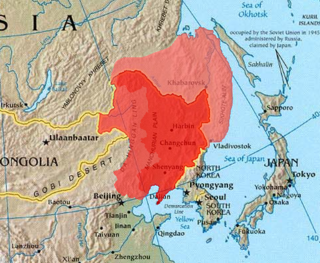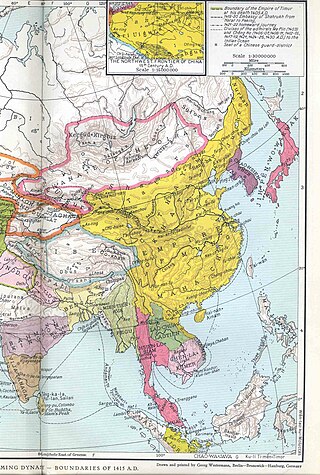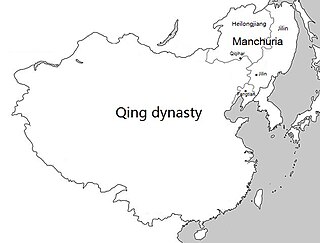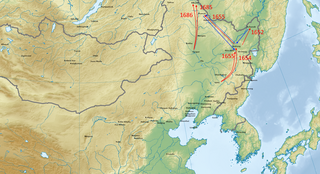Related Research Articles

Manchuria is a region in northeast Asia encompassing the entirety of present-day northeast China, and historically parts of the modern-day Russian Far East, often referred to as Outer Manchuria. The exact geographical extent varies depending on the definition: in the narrow sense, the area constituted by three Chinese provinces of Heilongjiang, Jilin, and Liaoning but broadly also including the eastern Inner Mongolian prefectures of Hulunbuir, Hinggan, Tongliao, and Chifeng, collectively known as Northeast China; in a broader sense, the area of historical Manchuria includes the aforementioned regions plus the Amur river basin, parts of which were ceded to the Russian Empire by the Manchu-led Qing dynasty during the Amur Annexation of 1858–1860. The parts of Manchuria ceded to Russia are collectively known as Outer Manchuria or Russian Manchuria, which include present-day Amur Oblast, Primorsky Krai, the Jewish Autonomous Oblast, the southern part of Khabarovsk Krai, and the eastern edge of Zabaykalsky Krai.

The Amur River or Heilong River is a perennial river in Northeast Asia, forming the natural border between the Russian Far East and Northeast China. The Amur proper is 2,824 km (1,755 mi) long, and has a drainage basin of 1,855,000 km2 (716,000 sq mi). If including its main stem tributary, the Argun, the Amur is 4,444 km (2,761 mi) long, making it the world's tenth longest river.

The Evenki, also known as the Evenks and formerly as the Tungus, are a Tungusic people of North Asia. In Russia, the Evenki are recognised as one of the Indigenous peoples of the Russian North, with a population of 38,396. In China, the Evenki form one of the 56 ethnic groups officially recognised by the People's Republic of China, with a population of 30,875. There are 537 Evenki in Mongolia, called Khamnigan in the Mongolian language.
The Manchus are a Tungusic East Asian ethnic group native to Manchuria in Northeast Asia. They are an officially recognized ethnic minority in China and the people from whom Manchuria derives its name. The Later Jin (1616–1636) and Qing (1636–1912) dynasties of China were established and ruled by the Manchus, who are descended from the Jurchen people who earlier established the Jin dynasty (1115–1234) in northern China.

Hong Taiji, also rendered as Huang Taiji and sometimes referred to as Abahai in Western literature, also known by his temple name as the Emperor Taizong of Qing, was the second khan of the Later Jin dynasty and the founding emperor of the Qing dynasty. He was responsible for consolidating the empire that his father Nurhaci had founded and laid the groundwork for the conquest of the Ming dynasty, although he died before this was accomplished. He was also responsible for changing the name of the Jurchens to "Manchu" in 1635, and changing the name of his dynasty from "Great Jin" to "Great Qing" in 1636.

The Daur people, Dagur, Daghur or Dahur are a Mongolic people originally native to Dauria and now predominantly located in Northeast China. The Daur form one of the 56 ethnic groups officially recognised in the People's Republic of China. They numbered 131,992 according to the latest census (2010) and most of them live in Morin Dawa Daur Autonomous Banner in Hulun Buir, northeastern Inner Mongolia and Meilisi Daur District in Qiqihar, Heilongjiang, Northeast China. Some Daur people also live near Tacheng in Xinjiang.

The House of Aisin-Gioro is a Manchu clan that ruled the Later Jin dynasty (1616–1636), the Qing dynasty (1636–1912), and Manchukuo (1932–1945) in the history of China. Under the Ming dynasty, members of the Aisin Gioro clan served as chiefs of the Jianzhou Jurchens, one of the three major Jurchen tribes at this time. Qing bannermen passed through the gates of the Great Wall in 1644, and eventually conquered the short-lived Shun dynasty, Xi dynasty and Southern Ming dynasty. After gaining total control of China proper, the Qing dynasty later expanded into other adjacent regions, including Xinjiang, Tibet, Outer Mongolia, and Taiwan. The dynasty reached its zenith during the High Qing era and under the Qianlong Emperor, who reigned from 1735 to 1796. This reign was followed by a century of gradual decline.

Manchuria is a region in East Asia. Depending on the definition of its extent, Manchuria can refer either to a region falling entirely within present-day China, or to a larger region today divided between Northeast China and the Russian Far East. To differentiate between the two parts following the latter definition, the Russian part is also known as Outer Manchuria, while the Chinese part is known as Northeast China.

The Sixty-Four Villages East of the River were a group of Manchu, Daur and Han-inhabited villages located on the left (north) bank of the Amur River opposite of Heihe, and on the east bank of Zeya River opposite of Blagoveshchensk. The area totaled 3,600 square kilometers (1,400 sq mi).

Tungusic peoples are an ethnolinguistic group formed by the speakers of Tungusic languages. They are native to Siberia, China, and Mongolia.

The Sino-Russian border conflicts (1652–1689) were a series of intermittent skirmishes between the Qing dynasty of China, with assistance from the Joseon dynasty of Korea, and the Tsardom of Russia by the Cossacks in which the latter tried and failed to gain the land north of the Amur River with disputes over the Amur region. The hostilities culminated in the Qing siege of the Cossack fort of Albazin in 1686 and resulted in the Treaty of Nerchinsk in 1689 which gave the land to China.

Nurhaci, also known by his temple name as the Emperor Taizu of Qing, was the founding khan of the Jurchen-led Later Jin dynasty.
Dular Bombogor was an Evenk chief, leader of the Evenk federation. His power base laid on the basin of the Amur river.
The Solon people are a subgroup of the Ewenki (Evenk) people of northeastern Asia. They live in China's Inner Mongolia Autonomous Region and Heilongjiang Province, and constitute the majority of China's Ewenki.
Identity in China was strongly dependent on the Eight Banner system during the Manchu-led Qing dynasty (1644–1912). China consisted of multiple ethnic groups, of which the Han, Mongols and Manchus participated in the banner system. Identity, however, was defined much more by culture, language and participation in the military until the Qianlong Emperor resurrected the ethnic classifications.

Manchuria under Ming rule refers to the domination of the Ming dynasty of China over the greater region of Manchuria, including today's Northeast China and Outer Manchuria. The Ming rule of Manchuria began with its conquest of Manchuria in the late 1380s after the fall of the Mongol-led Yuan dynasty, and reached its peak in the early 15th century with the establishment of the Nurgan Regional Military Commission. With the dissolution of the Nurgan Regional Military Commission the Ming power waned considerably in Manchuria. Starting in the 1580s, Nurhaci, the Jianzhou Jurchen chieftain who had been a Ming vassal, began to take control of most of Manchuria over the next several decades, and in 1616 he established the Later Jin and openly renounced Ming overlordship with the Seven Grievances. The Qing dynasty established by his son Hong Taiji would eventually conquer the Ming and take control of China proper.

Manchuria under Qing rule was the rule of the Qing dynasty of China over the greater region of Manchuria, including today's Northeast China and Outer Manchuria, although Outer Manchuria was lost to the Russian Empire after the Amur Annexation. The Qing dynasty itself was established by the Manchus, a Tungusic people from Manchuria, who later replaced the Ming dynasty as the ruling dynasty of China. Thus, the region is often seen to have had a special status during the Qing and was not governed as regular provinces until the late Qing dynasty, although the name "Manchuria" itself is an exonym of Japanese origin and was not used by the Qing dynasty in Chinese or Manchu.

The siege of Albazin was a military conflict between the Tsardom of Russia and Qing China from 1685 to 1686. It ultimately ended in the surrender of Albazin to Qing China and Russian abandonment of the Amur River area in return for trading privileges in Beijing.

The Chahar–Jurchen War was a military conflict waged between the Chahar Mongols and the Jurchen-led Later Jin dynasty and several other Mongol groups from 1619 to 1634.

The Battle of Hutong was a military conflict between the Tsardom of Russia and the Qing dynasty which occurred in the spring of 1654 on the Songhua River. Korean musketeers were also present from Joseon. It resulted in the retreat of Russian forces.
References
- 1 2 Narangoa 2014, p. 37.
- ↑ Narangoa 2014, p. 41.
- ↑ Narangoa 2014, p. 47.
- ↑ Crossley, Pamela Kyle (2002). A Translucent Mirror: History and Identity in Qing Imperial Ideology (illustrated, reprint ed.). University of California Press. p. 196. ISBN 978-0520234246.